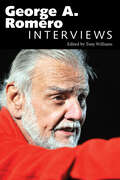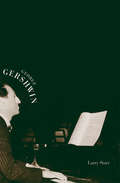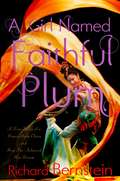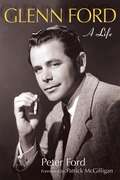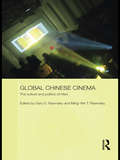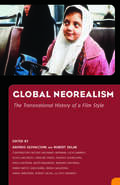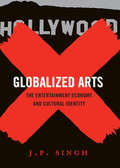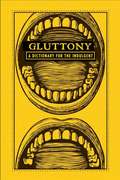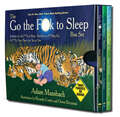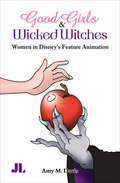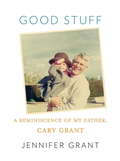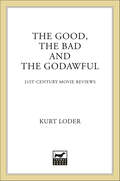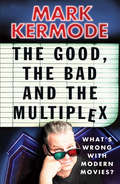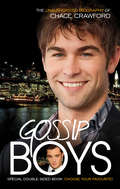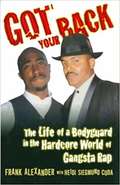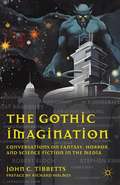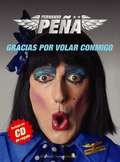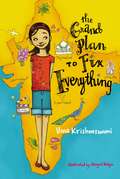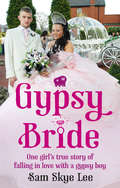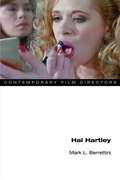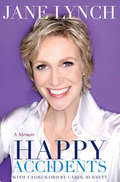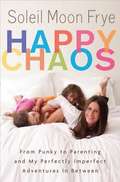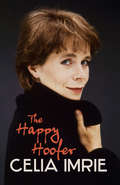- Table View
- List View
George A. Romero: Interviews (Conversations with Filmmakers Series)
by Tony WilliamsGeorge A. Romero (b. 1940) has achieved a surprising longevity as director since his first film, Night of the Living Dead (1968). After relocating to Canada, he shows no signs of slowing up: his recent film, Survival of the Dead (2009), is discussed in a new interview conducted by Tony Williams for this volume, and still other films are awaiting release. Although commonly known as a director of zombie films, a genre he himself launched, Romero's films often transcend easy labels. His films are best understood as allegorical commentaries on American life that just happen to appropriate horror as a convenient vehicle. Romero's films encompass works as different as The Crazies, Hungry Wives, Knightriders, and Bruiser. The interviews in this collection cover a period of over forty years. In whatever format they originally appeared—the printed page, the internet, or the video interview—these discussions illustrate both the evolution of Romero's chosen forms of technology and the development of his thinking about the relationship between cinema and society. They present Romero as an independent director in every sense of the word.
George Gershwin
by Larry StarrIn this welcome addition to the immensely popular Yale Broadway Masters series, Larry Starr focuses fresh attention on George Gershwin's Broadway contributions and examines their centrality to the composer's entire career. Starr presents Gershwin as a composer with a unified musical vision--a vision developed on Broadway and used as a source of strength in his well-known concert music. In turn, Gershwin's concert-hall experience enriched and strengthened his musicals, leading eventually to his great "Broadway opera,"Porgy and Bess. Through the prism of three major shows--Lady Be Good(1924),Of Thee I Sing(1931), andPorgy and Bess(1935)--Starr highlights Gershwin's distinctive contributions to the evolution of the Broadway musical. In addition, the author considers Gershwin's musical language, his compositions for the concert hall, and his movie scores for Hollywood in the light of his Broadway experience.
A Girl Named Faithful Plum: The True Story of a Dancer from China and How She Achieved Her Dream
by Richard BernsteinIn 1977, when Zhongmei Lei was eleven years old, she learned that the prestigious Beijing Dance Academy was having open auditions. She'd already taken dance lessons, but everyone said a poor country girl would never get into the academy, especially without any connections in the Communist Party of the 1970s. But Zhongmei, whose name means Faithful Plum, persisted, even going on a hunger strike, until her parents agreed to allow her to go. She traveled for three days and two nights to get to Beijing and eventually beat out 60,000 other girls for one of 12 coveted spots. But getting in was easy compared to staying in, as Zhongmei soon learned. Without those all-important connections she was just a little girl on her own, far away from family. But her determination, talent, and sheer force of will were not something the teachers or other students expected, and soon it was apparent that Zhongmei was not to be underestimated. Zhongmei became a famous dancer, and founded her own dance company, which made its New York debut when she was in just her late 20s. In A Girl Named Faithful Plum, her husband and renowned journalist, Richard Bernstein, has written a fascinating account of one girl's struggle to go from the remote farmlands of China to the world's stages, and the lengths she went to in order to follow her dream.From the Hardcover edition.
Global Chinese Cinema: The Culture and Politics of 'Hero' (Media, Culture and Social Change in Asia)
by Gary D. RawnsleyThe film Hero, directed by Zhang Yimou and released in 2002, is widely regarded as the first globally successful indigenous Chinese blockbuster. A big expensive film with multiple stars, spectacular scenery, and astonishing action sequences, it touched on key questions of Chinese culture, nation and politics, and was both a domestic sensation and an international hit. This book explores the reasons for the film’s popularity with its audiences, discussing the factors which so resonated with those who watched the film. It examines questions such as Chinese national unity, the search for cultural identity and role models from China’s illustrious pre-communist past, and the portrayal of political and aesthetic values, and attitudes to gender, sex, love, and violence which are relatively new to China. The book demonstrates how the film, and China’s growing film industry more generally, have in fact very strong international connections, with Western as well as Chinese financing, stars recruited from the East Asian region more widely, and extensive interactions between Hollywood and Asian artists and technicians. Overall, the book provides fascinating insights into recent developments in Chinese society, popular culture and cultural production.
Global Neorealism: The Transnational History of a Film Style
by Saverio GiovacchiniContributions by Nathaniel Brennan, Luca Caminati, Silvia Carlorosi, Caroline Eades, Saverio Giovacchini, Paula Halperin, Neepa Majumdar, Mariano Mestman, Hamid Naficy, Sada Niang, Masha Salazkina, Sarah Sarzynski, Robert Sklar, and Vito ZagarrioIntellectual, cultural, and film historians have long considered neorealism the founding block of post-World War II Italian cinema. Neorealism, the traditional story goes, was an Italian film style born in the second postwar period and aimed at recovering the reality of Italy after the sugarcoated moving images of fascism. Lasting from 1945 to the early 1950s, neorealism produced world-renowned masterpieces such as Roberto Rossellini's Roma, città aperta (Rome, Open City, 1945) and Vittorio De Sica's Ladri di biciclette (Bicycle Thieves, 1947). These films won some of the most prestigious film awards of the immediate postwar period and influenced world cinema. This collection brings together distinguished film scholars and cultural historians to complicate this nation-based approach to the history of neorealism. The traditional story notwithstanding, the meaning and the origins of the term are problematic. What does neorealism really mean, and how Italian is it? Italian filmmakers were wary of using the term and Rossellini preferred "realism." Many filmmakers confessed to having greatly borrowed from other cinemas, including French, Soviet, and American. Divided into three sections, Global Neorealism examines the history of this film style from the 1930s to the 1970s using a global and international perspective. The first section examines the origins of neorealism in the international debate about realist esthetics in the 1930s. The second section discusses how this debate about realism was “Italianized” and coalesced into Italian “neorealism” and explores how critics and film distributors participated in coining the term. Finally, the third section looks at neorealism’s success outside of Italy and examines how film cultures in Latin America, Africa, Asia, and the United States adjusted the style to their national and regional situations.
Globalized Arts: The Entertainment Economy and Cultural Identity
by J. P. SinghOur interactive world can take a creative product, such as a Hollywood film, Bollywood song, or Latin American telenovela, and transform it into a source of cultural anxiety. What does this artwork say about the artist or the world she works in? How will these artworks evolve in the global market? Film, music, television, and the performing arts enter the same networks of exchange as other industries, and the anxiety they produce informs a fascinating area of study for art, culture, and global politics.Focusing on the confrontation between global politics and symbolic creative expression, J. P. Singh shows how, by integrating themselves into international markets, entertainment industries give rise to far-reaching cultural anxieties and politics. With examples from Hollywood, Bollywood, French grand opera, Latin American television, West African music, postcolonial literature, and even the Thai sex trade, Singh cites not only the attempt to address cultural discomfort but also the effort to deny entertainment acts as cultural. He connects creative expression to clashes between national identities, and he details the effect of cultural policies, such as institutional patronage and economic incentives, on the making and incorporation of art into the global market. Ultimately, Singh shows how these issues affect the debates on cultural trade being waged by the World Trade Organization, UNESCO, and the developing world.
Globalized Arts: The Entertainment Economy and Cultural Identity
by J. P. SinghOur interactive world can take a cultural product, such as a Hollywood film, Bollywood song, or Latin American telenovela, and transform it into a source of cultural anxiety. What does this artwork say about the artist or the world she works in? How will these artworks evolve in the global market? Film, music, television, and the performing arts enter the same networks of exchange as other industries, and the anxiety they produce informs a fascinating area of study not only for art and culture but also for global politics. Focusing on the confrontation between global politics and symbolic creative expression, J. P. Singh shows how, by integrating themselves into international markets, entertainment industries give rise to far-reaching cultural anxieties. With examples from Hollywood, Bollywood, French grand opera, Latin American television, West African music, postcolonial literature, and even the Thai sex trade, Singh cites both the attempt to address cultural discomfort and the effort to deny entertainment acts as cultural. He connects creative expression to clashes between national identities, and he details the effect of cultural policies, such as institutional patronage and economic incentives, on the making and incorporation of art into the global market. Ultimately, Singh shows how these issues impact the debates on cultural trade being waged by the World Trade Organization, UNESCO, and the developing world.
Gluttony: A Dictionary tor the Indulgent
by Jennifer M. WoodThe Seven Deadly Sins have sliced up the dictionary and taken what's theirs. No one vice is too greedy as each volume prides itself on having more than 500 entries. Word lovers will lust after these richly packaged volumes--and once you've collected all seven, you'll be the envy of all your friends. Gluttony: A Dictionary for the Indulgent Readers can devour word after word after word until they've had their fill. And then they can have some more. This bite-size book serves up a hefty sampling of juicy words. It's a wonderful treat for the Gluttonous.
The Go the Fuck to Sleep Box Set: Go The Fuck To Sleep, You Have To Fucking Eat And Fuck, Now There Are Two Of You
by Adam MansbachCelebrating a decade of profane, loving, and deeply cathartic children’s books for adults, the entire Go the Fuck to Sleep trilogy is finally available in a collectors’-edition boxed set. "You've probably heard of the book Go the F**k to Sleep and its two sequels—You Have to F**king Eat and F**k, Now There Are Two of You. But did you know it's been a full decade since the first book become a brilliant and hilarious phenomenon?"—Fatherly TEN YEARS AGO, Adam Mansbach crystallized the secret agony of parents the world over with one simple phrase: Go the Fuck to Sleep. In verses that perfectly capture the familiar tribulations of putting your little angel down for the night, the book opened up a conversation about parenting, granting us permission to admit our frustrations, and laugh at their absurdity . . . and the message only resonated louder when Samuel L. Jackson, the bard of the F-word, read the audiobook. You Have to Fucking Eat expanded the conversation to include parenthood's other universal frustration: getting your little angel to eat something that even vaguely resembles a normal meal, with Bryan Cranston voicing the audiobook . . . and because life moves pretty fast, Fuck, Now There Are Two of You soon became necessary, to address the fact that two is, somehow, a million more kids than one—with Larry David doing the audiobook honors. And now, to celebrate a decade of profane, loving, and deeply cathartic children's books for adults, the entire trilogy is finally available in a collectors'-edition boxed set, perfect for gifting at a baby shower or using to knock yourself unconscious. As always . . . you probably should not read these books to a child.
Good Girls and Wicked Witches: Women in Disney's Feature Animation
by Amy M. DavisIn Good Girls and Wicked Witches, Amy M. Davis re-examines the notion that Disney heroines are rewarded for passivity. Davis proceeds from the assumption that, in their representations of femininity, Disney films both reflected and helped shape the attitudes of the wider society, both at the time of their first release and subsequently. Analyzing the construction of (mainly human) female characters in the animated films of the Walt Disney Studio between 1937 and 2001, she attempts to establish the extent to which these characterizations were shaped by wider popular stereotypes. Davis argues that it is within the most constructed of all moving images of the female form--the heroine of the animated film--that the most telling aspects of Woman as the subject of Hollywood iconography and cultural ideas of American womanhood are to be found.
Good Stuff
by Jennifer GrantJennifer Grant is the only child of Cary Grant, who was, and continues to be, the epitome of all that is elegant, sophisticated, and deft. Almost half a century after Cary Grant's retirement from the screen, he remains the quintessential romantic comic movie star. He stopped making movies when his daughter was born so that he could be with her and raise her, which is just what he did. Good Stuff is an enchanting portrait of the profound and loving relationship between a daughter and her father, who just happens to be one of America's most iconic male movie stars.Cary Grant's own personal childhood archives were burned in World War I, and he took painstaking care to ensure that his daughter would have an accurate record of her early life. In Good Stuff, Jennifer Grant writes of their life together through her high school and college years until Grant's death at the age of eighty-two. Cary Grant had a happy way of living, and he gave that to his daughter. He invented the phrase "good stuff" to mean happiness. For the last twenty years of his life, his daughter experienced the full vital passion of her father's heart, and she now--delightfully--gives us a taste of it. She writes of the lessons he taught her; of the love he showed her; of his childhood as well as her own . . . Here are letters, notes, and funny cards written from father to daughter and those written from her to him . . . as well as bits of conversation between them (Cary Grant kept a tape recorder going for most of their time together).She writes of their life at 9966 Beverly Grove Drive, living in a farmhouse in the midst of Beverly Hills, playing, laughing, dining, and dancing through the thick and thin of Jennifer's growing up; the years of his work, his travels, his friendships with "old Hollywood royalty" (the Sinatras, the Pecks, the Poitiers, et al.) and with just plain-old royalty (the Rainiers) . . . We see Grant the playful dad; Grant the clown, sharing his gifts of laughter through his warm spirit; Grant teaching his daughter about life, about love, about boys, about manners and money, about acting and living.Cary Grant was given the indefinable incandescence of charm. He was a pip . . . Good Stuff captures his special quality. It gives us the magic of a father's devotion (and goofball-ness) as it reveals a daughter's special odyssey and education of loving, and being loved, by a dad who was Cary Grant.From the Hardcover edition.
The Good, the Bad, and the Godawful: 21st-Century Movie Reviews
by Kurt LoderThe former Rolling Stone writer and MTV host takes off from classic Roger Ebert and sails boldly into the new millennium.Millions grew up reading the author's record reviews and watching him on MTV's "The Week in Rock." In this collection of more than 200 movie reviews from MTV.com and, more recently, the Reason magazine Website, plus sidebars exclusive to this volume, Loder demonstrates his characteristic wry voice and finely honed observations. The author shines when writing on the best that Hollywood and indie filmmakers have to offer, and his negative reviews are sometimes more fun than his raves. This freewheeling survey of the wild, the wonderful and the altogether otherwise is an indispensable book for any film buff.
The Good, The Bad and The Multiplex
by Mark KermodeIf blockbusters make money no matter how bad they are, then why not make a good one for a change?How can 3-D be the future of cinema when it's been giving audiences a headache for over a hundred years? Why pay to watch films in cinemas that don't have a projectionist but do have a fast-food stand? And, in a world where Sex and the City 2 was a hit, what are film critics even for? Outspoken, opinionated and hilariously funny, The Good, The Bad and The Multiplex is a must for anyone who has ever sat in an undermanned, overpriced cinema and wondered: 'How the hell did things get to be this terrible?'
Gossip Boys: The double unauthorised biography of Ed Westwick and Chace Crawford
by Liz KayeOMG. It's Chuck Bass and Nate Archibald from Gossip Girl in one book. We're all mad about the boys, but is it Ed Westwick's bad-guy allure that ticks your box, or Chace Crawford's pretty-boy looks? Or - naughty - both? Well, to help you decide, Gossip Boys, the unauthorised double biography of Chace and Ed, charts the lives of these hot young things, who are best friends both on the show and in real life. Brit-born Westwick has the edgy cool of his character, having fronted the indie band The Filthy Youth, and appearing in cult films such as Son of Rambow and Children of Men. Crawford meanwhile is the ultimate all-American idol, signed by the first talent agent who interviewed him and being named 'Summer's Hottest Bachelor' by People and winning the Teen Choice Award for 'Male Hottie'. The huge success of Gossip Girl has seen these actors become two of the biggest pin-ups around, and favourites of magazines like Grazia and teen TV programming such as T4. Now you can learn all about the boys: their early days, their flames old and new, their careers and the bromance that has made them scorching stars.
Got Your Back: Protecting Tupac in the World of Gangsta Rap
by Heidi Cuda Frank AlexanderOn September 13, 1996, Tupac Shakur was shot and killed in Las Vegas. Millions of fans wept, while many critics claimed it was the inevitable result of a thugged-out lifestyle. The mystery surrounding the shooting-a suspect has yet to be named-has increased, and rumors of gang wars, disloyalty, and government conspiracies continue to linger. Only Frank Alexander, Tupac's bodyguard druing the last year of his life, knows the real story. Got Your Back details the exploits of one of the most famous rappers of all time. The drugs, the women, the violence, the money-all provided fuel to the fire that was Tupac's life. As his platinum-selling, posthumously released albums prove, Tupac lives on through his music. Complete with exclusive new interview material with Tupac's mother, Afeni, Got Your Back provides an insider's view of a life gone awry.
The Gothic Imagination
by John C. TibbettsThis book brings together the author's interviews with many prominent figures in fantasy, horror, and science fiction to examine the traditions and extensions of the gothic mode of storytelling over the last 200 years and its contemporary influence on film and media.
Gracias por volar conmigo
by Fernando PeñaFernando Peña fue durante 11 años comisario de abordo. En este librocuenta de manera desopilante cómo es trabajar en el cielo. Anécdotas, confesiones, sueños, aterrizajes forzosos, pasajeros,tripulantes, pilotos, destinos, amantes, familia, compañeros, baños,closets, pasiones, corderos, sexo, secretos, apretujes, ciudades,carcajadas, chistes, cargadas, placeres, hoteles, Londres, Nueva York,Miami, personajes, novios, miedos, cómplices, etc., etc. .
The Grand Plan to Fix Everything
by Abigail Halpin Uma KrishnaswamiRose petal milk shakes and a world of surprises awaits Dini when her family moves to India in this spirited novel with Bollywood flair. <p><p> Eleven-year old Dini loves movies--watching them, reading about them, trying to write her own--especially those oh-so-fabulous Bollywood movies where you don't need to know the language to get what's going on. But when her mother reveals some big news, it does not at all jibe with the script Dini had in mind. Her family is moving to India. And not even to Bombay, which is the "center of the filmi universe" (and home to Dini's all-time most favorite star, Dolly Singh). No, they're moving to a teeny, tiny town that she can't even find on a map: Swapnagiri. It means Dream Mountain, a sleepy little place where nothing interesting can happen.... <p> But wait a movie minute! Swapnagiri is full of surprises like rose petal milk shakes, mischievous monkeys, a girl who chirps like a bird, and...could it be...Dolly herself?
The Grand Plan to Fix Everything
by Uma Krishnaswami Abigail HalpinEleven-year old Dini loves movies--watching them, reading about them, trying to write her own--especially Bollywood movies. But when her mother tells her some big news, it does not at all jive with the script of her life she has in mind. Her family is moving to India...and, not even to Bombay, which is the center of the Bollywood universe and home to Dini's all-time most favorite star, Dolly. No, Dini is moving to a teeny, tiny village she can't even find on a map. Swapnagiri. It means Dream Mountain and it only looks like a word that's hard to pronounce. But to that open-minded person who sounds the name out, one letter at a time, it falls quite handily into place: S-w-a-p-n-a-g-i-r-i. An honest sort of name, with no surprise letters waiting to leap out and ambush the unwary. That doesn't mean there aren't surprises in Swapnagiri like mischievous monkeys and a girl who chirps like a bird--and the biggest surprise of all: Dolly. So now, Dini is hard at work on a new script, the script in which she gets to meet the amazing Dolly. But, life is often more unpredictable than the movies and when Dini starts plotting her story things get a little out of control. This is a joyful, lively Bollywood inspired story is full of colorful details, delicious confections and the wondrous, magical powers of coincidence. Uma Krisnaswami will have you smiling from ear to ear.
Gypsy Bride: One girl's true story of falling in love with a gypsy boy
by Sam Skye Lee'I felt like Cinderella, Sleeping Beauty, Snow White and all the other fairy-tale princesses, and Pat was my Prince Charming.'Sam Skye Lee had often thought about getting married, but never imagined that her dress would be bright pink with flashing lights and weigh a staggering 20-stone. But then she didn't count on having a gypsy wedding...It's rare for a 'gorger', or non-traveller, to marry into the gypsy community. But after a shocking childhood tragedy, Sam found the comfort she needed from an unxpected source - Patrick and his family of travellers.Gypsy Bride is the heartwarming true story of how an ordinary girl finds herself discovering an extraordinary world. A place where 'grabbing' is a sign a boy fancies you, six-year-olds get spray tans, and christenings, weddings and funerals are jaw-droppingly flamboyant.This love story is more than boy meets girl. It's about a girl who falls in love with a whole race of people and their wonderful ways.
Hal Hartley (Contemporary Film Directors)
by Mark L. BerrettiniSince the late 1980s, Hal Hartley has challenged standards of realist narrative cinema with daring narrative constructions, character development, and the creation of an unconventional visual world. In this pioneering critical overview of his work and its cultural-historical context, Mark L. Berrettini discusses seven of Hartley's feature films, including The Unbelievable Truth, Trust, Simple Men, Amateur, Henry Fool, Fay Grim, and The Book of Life. Drawing on journalism, theories of representation, narrative and genre, and cinema history, Berrettini discusses the absurdist-comedic representation of serious themes in Hartley's films: impossible love, coincidence and human relations, extreme isolation, and the restrictions posed by gender norms. He looks at the films' consistently absurd tone and notes how these themes reappear within framing narratives that shift from the seemingly mundane in Hartley's earliest works to the vibrantly creative and fantastic in his later films. Employing close analysis and theories related to cinematic narrative and to realism, the book's critical appraisal of Hartley's films considers aspects of American independent cinema and postwar European cinema, antirealism, and minimalism. The volume concludes with a pair of in-depth interviews with the director from two distinct points in his career.
Happy Accidents
by Jane LynchIn the summer of 1974, a fourteen-year-old girl in Dolton, Illinois, had a dream. A dream to become an actress, like her idols Ron Howard and Vicki Lawrence. But it was a long way from the South Side of Chicago to Hollywood, and it didn't help that she'd recently dropped out of the school play, The Ugly Duckling. Or that the Hollywood casting directors she wrote to replied that "professional training was a requirement."But the funny thing is, it all came true. Through a series of happy accidents, Jane Lynch created an improbable--and hilarious--path to success. In those early years, despite her dreams, she was also consumed with anxiety, feeling out of place in both her body and her family. To deal with her worries about her sexuality, she escaped in positive ways--such as joining a high school chorus not unlike the one in Glee--but also found destructive outlets. She started drinking almost every night her freshman year of high school and developed a mean and judgmental streak that turned her into a real-life Sue Sylvester.Then, at thirty-one, she started to get her life together. She was finally able to embrace her sexuality, come out to her parents, and quit drinking for good. Soon after, a Frosted Flakes commercial and a chance meeting in a coffee shop led to a role in the Christopher Guest movie Best in Show, which helped her get cast in The 40-Year-Old Virgin. Similar coincidences and chance meetings led to roles in movies starring Will Ferrell, Paul Rudd, and even Meryl Streep in 2009's Julie & Julia. Then, of course, came the two lucky accidents that truly changed her life. Getting lost in a hotel led to an introduction to her future wife, Lara. Then, a series she'd signed up for abruptly got canceled, making it possible for her to take the role of Sue Sylvester in Glee, which made her a megastar.Today, Jane Lynch has finally found the contentment she thought she'd never have. Part comic memoir and part inspirational narrative, this is a book equally for the rabid Glee fan and for anyone who needs a new perspective on life, love, and success.WITH A FOREWORD BY CAROL BURNETThat anxiety and fear didn't help, nor did it fuel anything useful. My final piece of advice to twenty-year-old me: Be easy on your sweet self. And don't drink Miller Lite tall boys in the morning.
Happy Chaos
by Frye Soleil MoonFrom Punky to parenting, Soleil Moon Frye shares insightful, realistic, in-the-trenches parenting advice, inspiration, and fun.
The Happy Hoofer
by Celia Imrie‘I’ve always been wilful...I’ve always been stubborn and always determined’One of our best-loved actresses, Celia Imrie would rather have been a dancer. As a child she planned to join the Royal Ballet and marry Rudolf Nureyev. Now she has become one of our finest and funniest performers, on stage, TV and screen - adored for her roles in Acorn Antiques and dinnerladies, as well as films including Calendar Girls and Nanny McPhee. In her hugely entertaining autobiography Celia Imrie recounts a life hurtling (not always intentionally) into adventures both on stage and off. Whether it’s finding herself on stage with half the scenery stuck to her cardigan, or being kidnapped on her way to location. Somehow she emerges from the chaos that can lie in her wake almost unscathed. Acting, she admits, is a mad, chaotic profession and it is her refreshing honesty, sense of mischief, fun and almost unruffled determination in the face of it all that makes this autobiography a never-ending delight.
